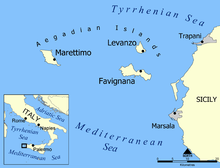Battle of the Cigno Convoy
In March the rate of loss reached 50 per cent and by April, Axis merchant ship sinkings averaged of 3.3 per day.
After eight hours the British destroyers passed Pantelleria at 20 kn (23 mph; 37 km/h) with Pakenham in the lead and Paladin .3 nmi (0.35 mi; 0.56 km) astern.
Cassiopea, having steered north north-west to confront Paladin, opened fire at 4,500 yd (2.2 nmi; 2.6 mi; 4.1 km).
Pakenham received a second hit at 02:50 which exploded in the lower deck and caused a much bigger fire, leading to Stevens ordering the aft magazine to be flooded.
Pakenham hit Cigno in the forward boiler just to the rear of the bridge at 02:53, releasing a large cloud of smoke and steam over the ship as it came to a stop.
[11][a] The stern quickly sank but the forward section of the ship stayed afloat; its 100 mm (3.9 in) gun-crew continuing to fire.
The crews of the two 100 mm (3.9 in) guns to the rear remained in action and at 03:06 Cassiopea fired a torpedo at 1,200 yd (0.59 nmi; 0.68 mi; 1.1 km) to no effect.
Paladin was taking evasive action and broke away to the south-east, after its captain mistook Cassiopea for a Capitani Romani-class cruiser, because Italian shells exploding in the water caused unusually large splashes.
[13] In 2009, Vincent O'Hara wrote that the Battle of the Cigno Convoy was a rare occasion when Italian naval escorts defeated a night attack by British ships.
O'Hara wrote that experience had more influence on the result; the British ships had recently been transferred from the Indian Ocean and Rich deciding to turn away was "unusually cautious".
Jones could shut off the steam and wait for the engine room to cool before making repairs but this would take two hours or keep going until the boiler feed-water ran out and the ship stopped in the water.
With Axis airfields so close, Jones continued and made another 13 nmi (15 mi; 24 km) before losing power, stopping at 03:50.

